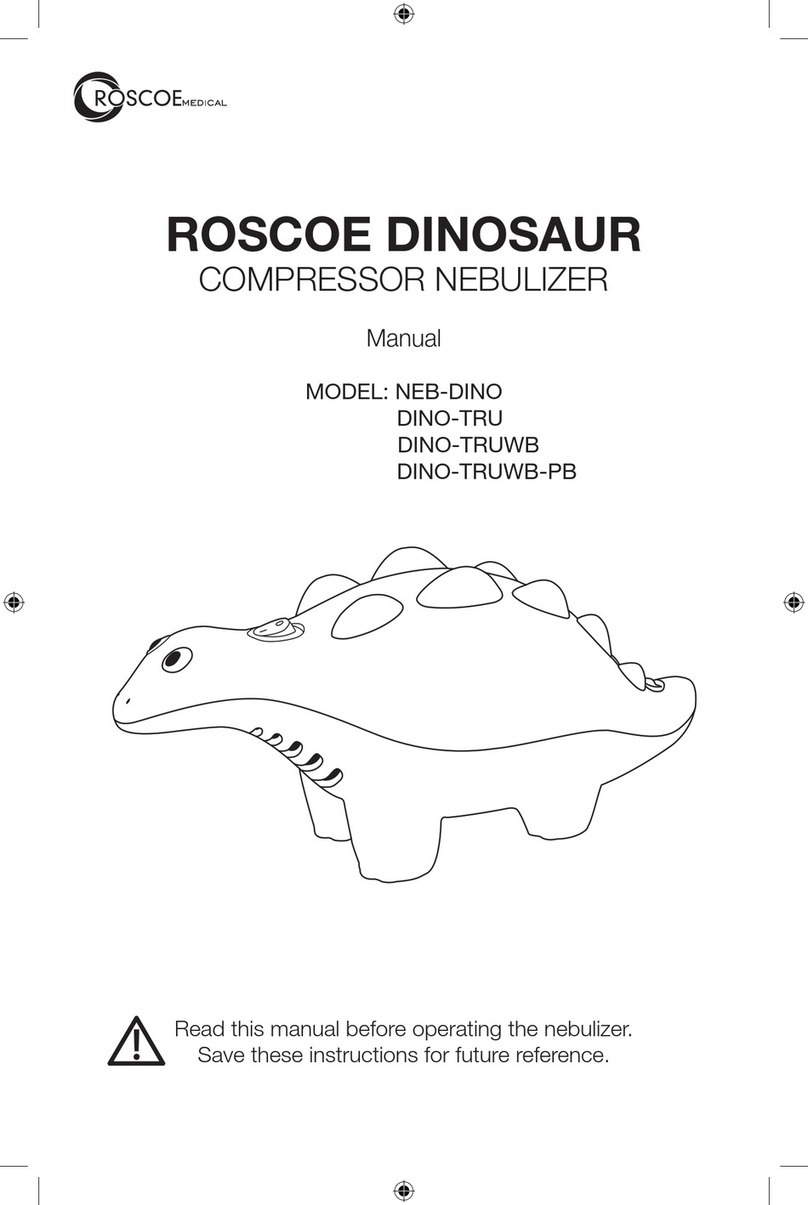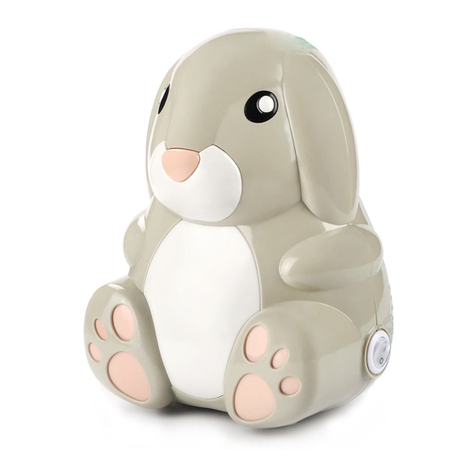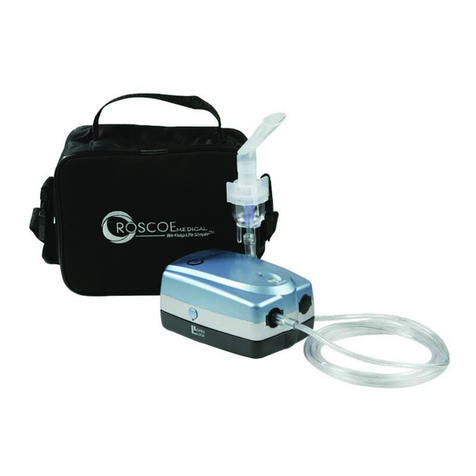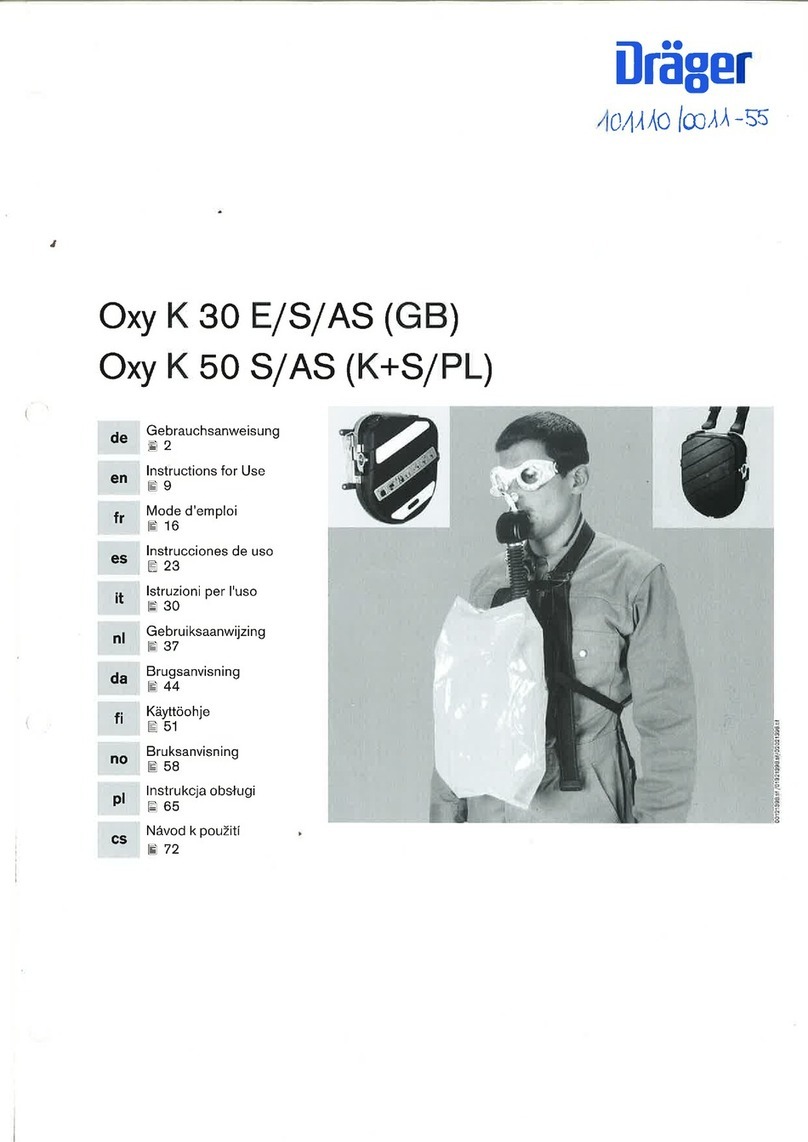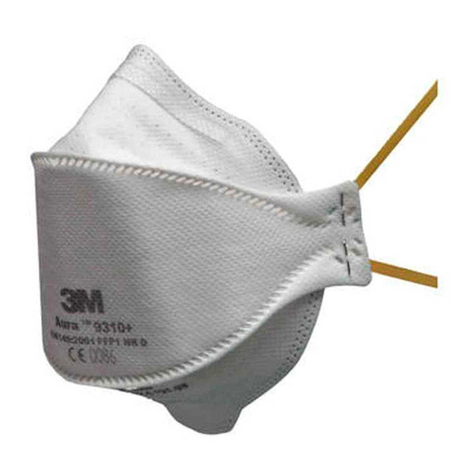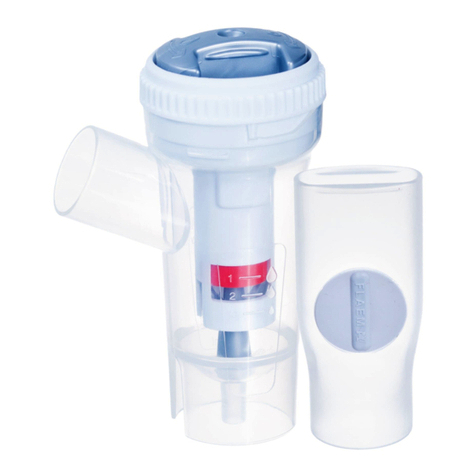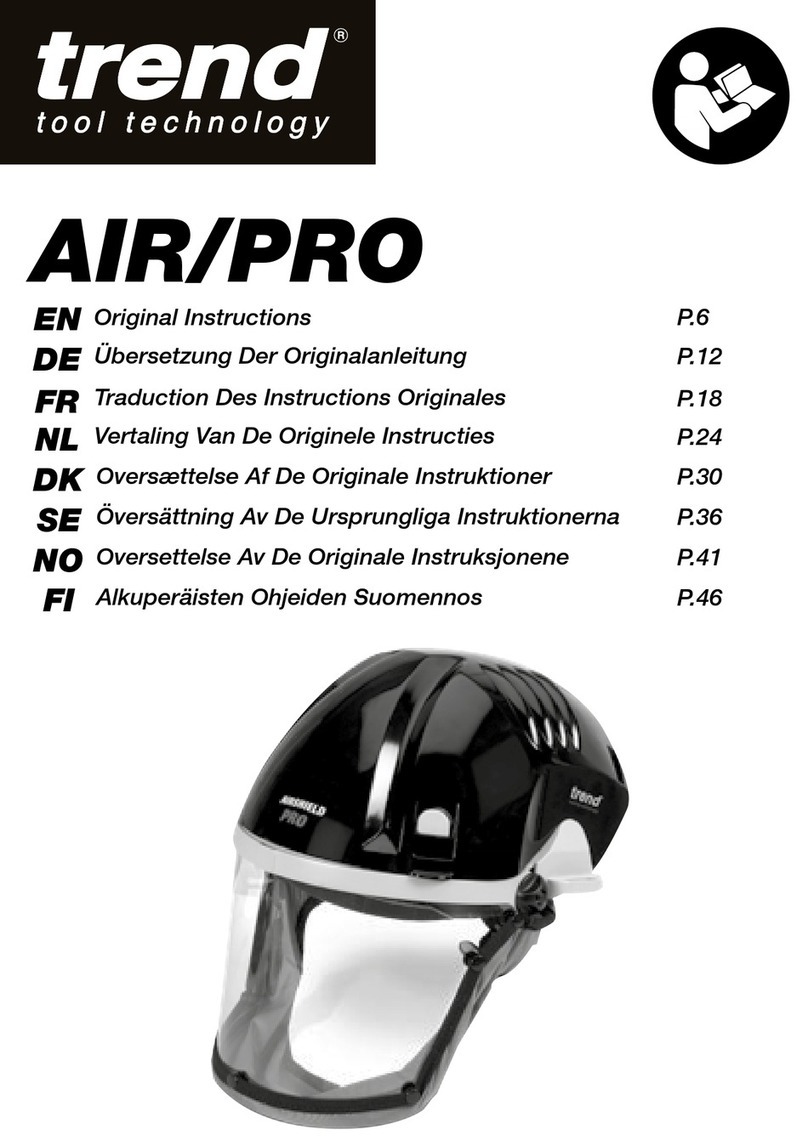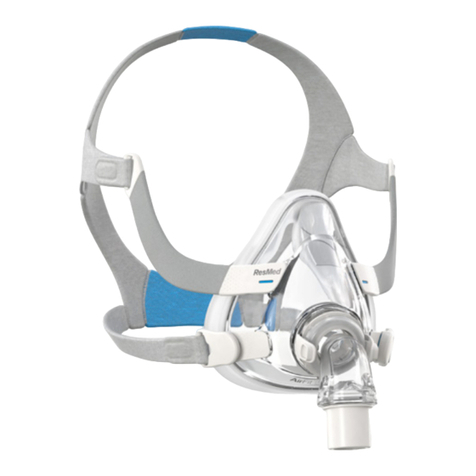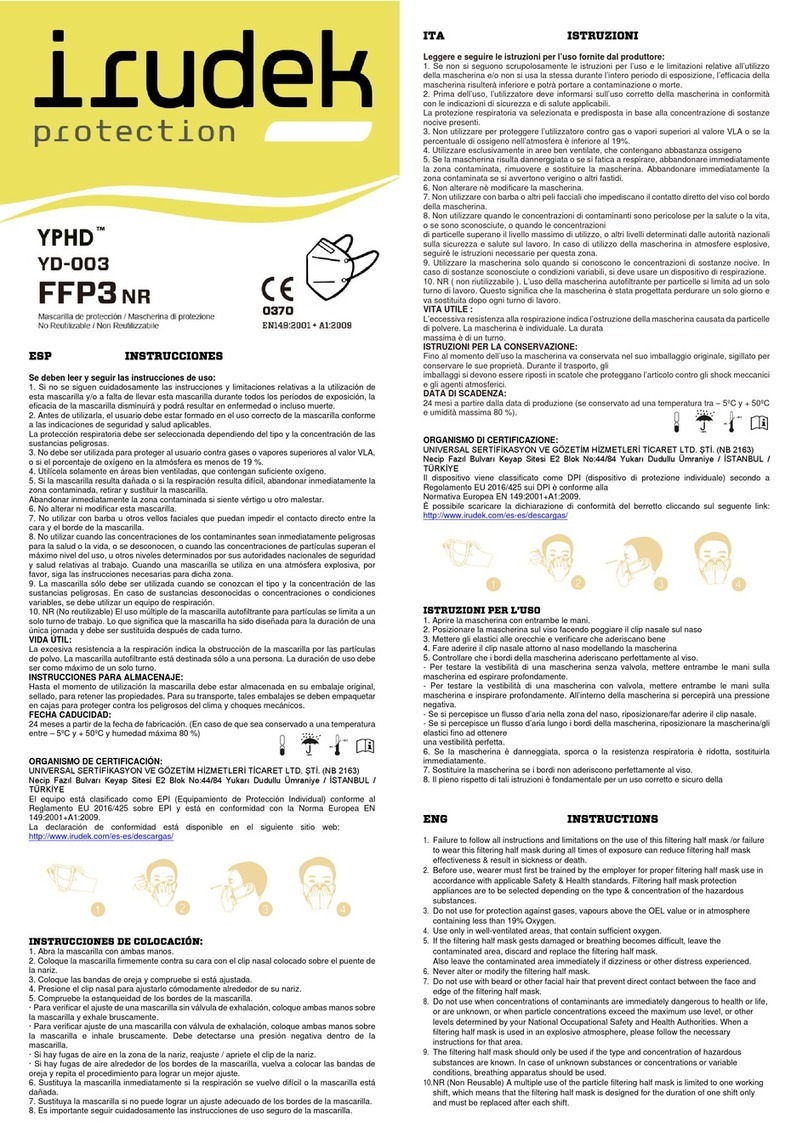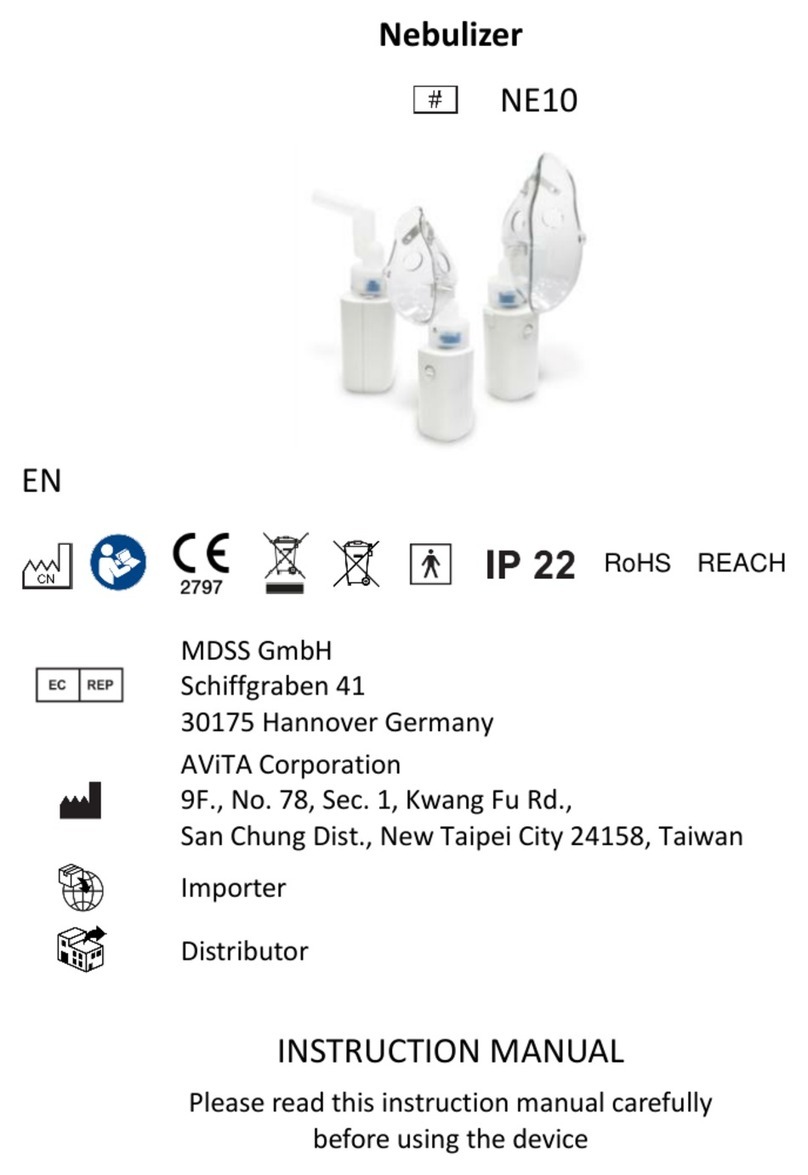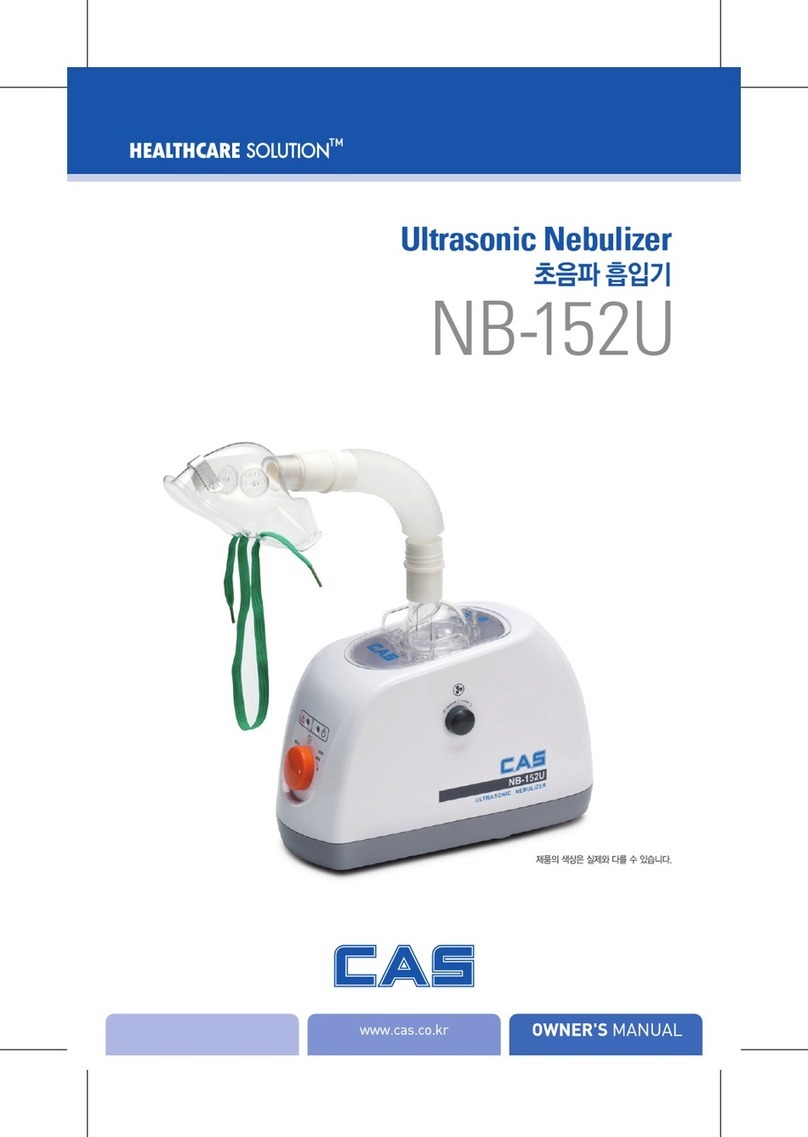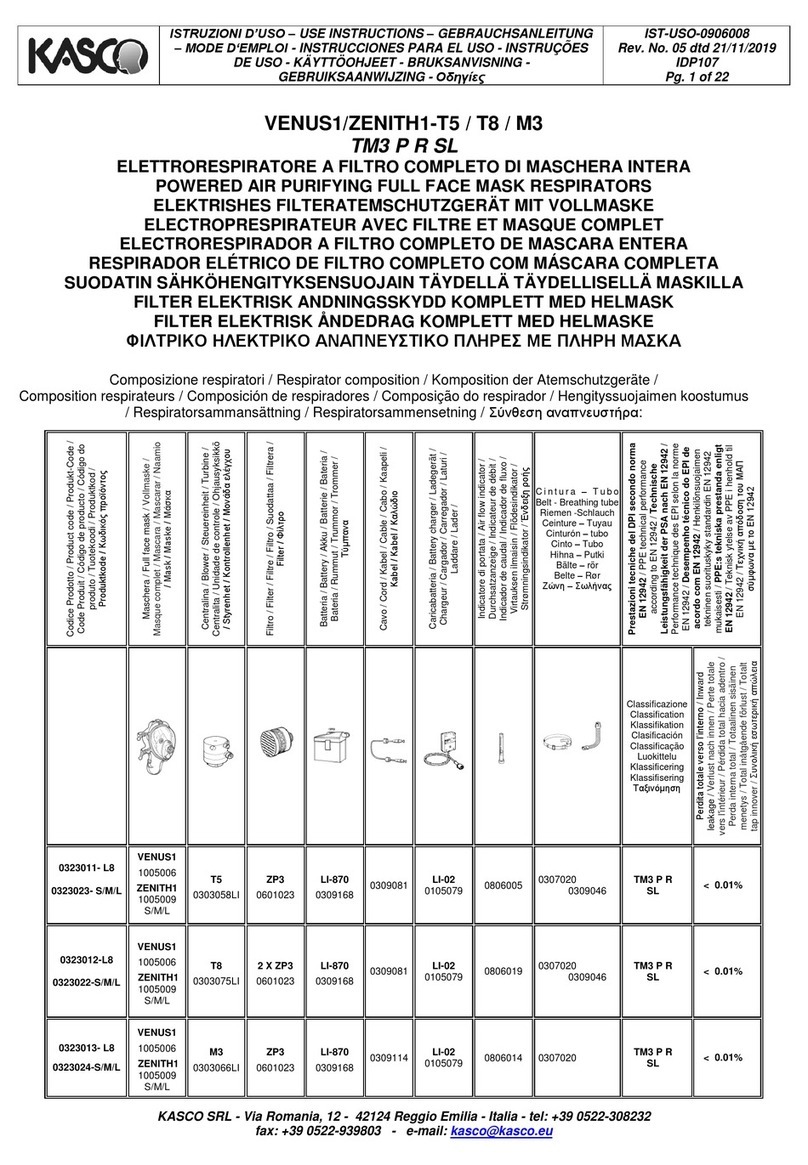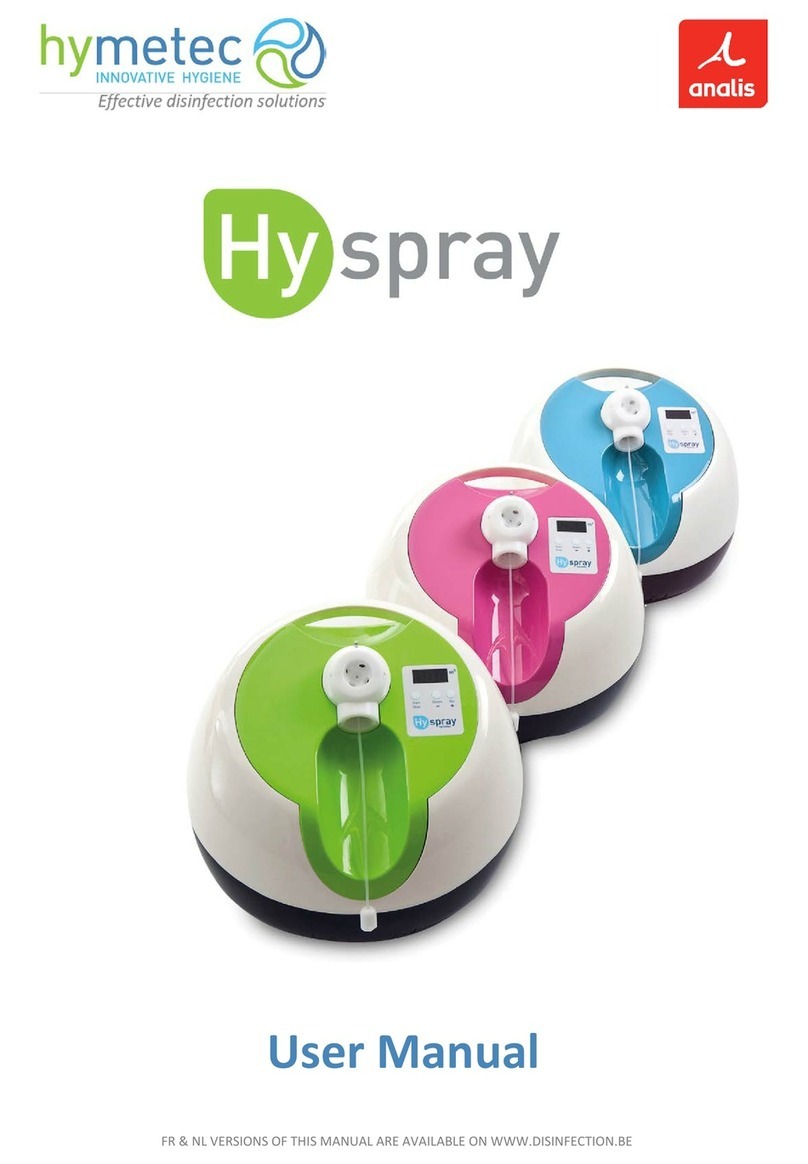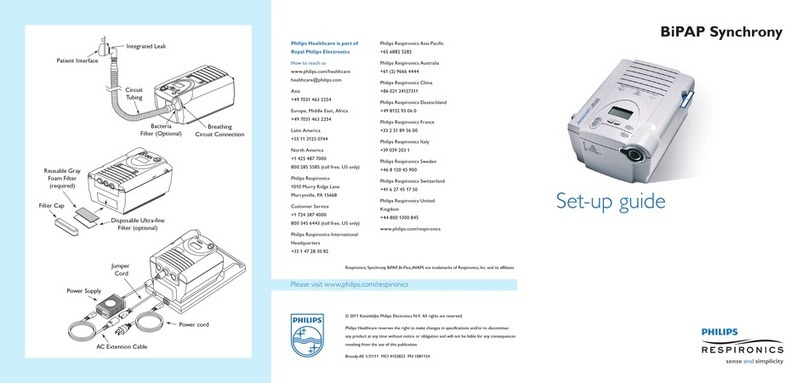Roscoe Medical SierraNeb2 User manual

Compressor Nebulizer
USER’S MANUAL
Read this manual before operating the nebulizer.
Save these instructions for future reference.

2
INDEX
Page
1. Illustration of Parts 3
2. Introduction 4
3. Safety Precautions. 4
3-1. Nebulizer Compressor Safety Precautions 4
3-2. Nebulizer and Accessories Safety Precautions 6
4. Getting Started 6
5. Setting Up the Nebulizer Compressor and
Nebulizer Accessories 7
6. Operating Cautions 10
7. Operating the Compressor Nebulizer 10
8. Cleaning the Nebulizer Components / Accessories 12
9. Disinfecting & Sterilizing Nebulizer Components
& Accessories 12
10. Maintenance 13
11. Nebulizer Specifications 14
12. Limited Warranty 15
13. Service and Repair 15

3
1. ILLUSTRATION OF PARTS
A. NEBULIZER COMPRESSOR UNIT
1. Compressor
2.Air Outlet
3. Power Switch
4. Power Cord (Not Pictured)
5.Air Filter
Figure 1
B. NEBULIZER ASSEMBLY AND ACCESSORIES ILLUSTRATION
1.Tubing
2. Nebulizer Cup
3. Nebulizer Insert
4. Nebulizer Cap
5. Mouthpiece
Figure 2
1
2
5
3
5
4
3
2
1

4
2. INTRODUCTION
This nebulizer is a portable medical device intended to aerosolize physician-prescribed
medication which is inhaled through a mouthpiece or mask. A nebulizer may be
used instead of a metered dose inhaler.The device consists of a compressor unit
and nebulizing attachments.
These instructions contain important information and safety precautions for the nebulizer.
Illustrations of the compressor unit and tubing and accessories are on page 3 . Before
using your nebulizer, you should read and understand the entire User’s Manual for the
compressor unit, tubing and accessories.Take special note of all safety precautions marked
DANGER and WARNING. Keep the user’s manual tor future reference.
3. SAFETY PRECAUTIONS
IMPORTANT SAFEGUARDS
READ ALL WARNINGS BEFORE USING YOUR NEBULIZER.
WARNING
U.S. Federal Law restricts this device to sale by or on the order of a physician. Use only
when prescribed by a physician and with the prescribed medication.
Read all warnings and user’s manual before use. Use the product only for its intended use
as described in the user’s manual. Improper use can result in serious or fatal illness / injury,
improper treatment or property damage.
Use only with nebulizers, tubing and accessories approved for this device. Other tubing
and accessories may result in improper treatment.
CAUTION
This appliance is not for unattended use.
3-1. NEBULIZER COMPRESSOR SAFETY PRECAUTIONS
WARNING
WARNING: IF ANY OF THE MOTOR HOUSING PARTS SHOULD BECOME DETACHED
OR BROKEN, EXPOSING THE MOTOR OR ANY OTHER ELECTRICAL COMPONENTS,
OPERATION SHOULD BE DISCONTINUED IMMEDIATELY TO AVOID PERSONAL
INJURY OR FURTHER PRODUCT DAMAGE.

5
WARNING
To reduce the risk of serious or fatal injury from electrocution, fire, burns and to
reduce the risk of damage or malfunction of the unit:
1. Before use, check the serial number label on the bottom of the compressor to ensure
that the voltage and current indicated on the unit correspond with the voltage and
current available.
2. Never operate this product if it:
• has a damaged cord or plug
• is not working properly
• has been dropped or damaged
• has been exposed to any liquids inside the case
Return non-operating product to an authorized Roscoe dealer for repair or replacement.
3. Keep all electrical cords away from heated surfaces. Do not overload wall outlets
or use extension cords.
4. Do not operate where oxygen is being administered in a closed environment
such as an oxygen tent.
5. Never drop or insert any object into any openings.
6. Do not open or disassemble the compressor. Refer all servicing to a Roscoe
authorized dealer.
7. Never spray liquids onto the compressor housing. Fluid could cause damage to the
electrical and compressor parts and could lead to a malfunction. In the event that fluids
enter the unit, return the product to major or authorized medical equipment service
center for examination and repair.
8. Do not use the nebulizer while operating a vehicle.
9. EMI/RFI recommendations:
a. Do not turn on or use hand-held personal electronic communication devices such as
cellular phones, walkie-talkies and CB radios while the compressor is turned on.
b. Be aware of any nearby transmitters (radio, television, microwave, etc.) and avoid
operating the compressor close to any of these transmitters.
c.Turn off the power if the compressor is not going to be used for any length of time.
d. Be aware that adding accessories or components or modifying the compressor may
make it more susceptible to EMI/RFI.

6
3-2. NEBULIZER AND ACCESSORIES SAFETY PRECAUTIONS
WARNING
1.Tubing and accessories are for a single patient use only. Do not share your tubing and
accessories with other patients.
2.To reduce the risk of increased bacterial growth, infection, illness, or injury from
contamination, thoroughly clean and dry all parts of tubing and accessories and
thoroughly dry any moisture or condensation in the tubing at the end of every
treatment, following the instructions below.
3. Cleaning the nebulizer unit after each treatment is not enough.The tubing and
accessories must also be regularly sterilized and disinfected between treatments
to prevent serious or fatal illness caused by contamination.
4. Never use tubing with a clogged nozzle. lf the nozzle is clogged, the aerosol
mist will be reduced, altered or stopped, which will diminish or eliminate the
effectiveness of the treatment. If clogging occurs, replace with the same model.
5. Close supervision is necessary when this product is used by or near children
and physically or mentally impaired persons. Never use when sleeping or drowsy.
6.This product contains small parts that may present a choking hazard to small
children.The tubing also presents a strangulation hazard.
WARNING:ALWAYS USE CLOSE ADULT SUPERVISION WHEN ADMINISTER-
ING TREATMENT TO A CHILD. DO NOT LEAVE CHILD UNAT-
TENDED DURING TREATMENT.
7. Children under the age of 3 or any patient who is unable to use a mouthpiece
properly under supervision should use a mask (optional).
8. Before use, check tubing and accessories for proper assembly. All parts should be
seated firmly in place. Use of improperly assembled tubing and accessories could
diminish or prevent adequate delivery of medication and the effectiveness of
the treatment.
4. GETTING STARTED
1. Check to ensure the following component of the nebulizer are enclosed:
• Compressor unit
• Tubing and accessories (see page 3 for illustration of parts)
If you did not receive the components listed, please contact the dealer
where you purchased your nebulizer.
2. It is always a good idea to keep extra tubing and accessories and an extra air filter
on hand at all times.You may need them if parts become lost, damaged, or soiled.

7
5. SETTING UP THE NEBULIZER COMPRESSOR AND
NEBULIZER ACCESSORIES
1.Wash hands with soap and warm water and dry completely with a clean towel.
2. Place the compressor on a clean dust-free, stable and flat surface. Check the filter
monthly or every 10 – 12 treatments and replace if dirty, clogged, or wet to ensure
proper operation .
Note:Tubing and accessories are NOT sterile from package.
3. Make sure tubing and accessories have been cleaned and/or disinfected before first
use and after last daily treatment. Refer to the Cleaning and Disinfecting Tubing and
Accessories section on page 12.
4. Remove the nebulizer cap by twisting counter-clockwise until it stops and
lift up (Figure 3-1).
5. Fill nebulizer cup using eyedropper or syringe with prescribed medication. Do not fill
more than 8 ml per treatment (Figure 3-2).
6. Close the nebulizer cap and turn clockwise until it is tightened (Figure 3-3).
Figure 3-1 Figure 3-2 Figure 3-3

8
7. If using the mask, (optional) press it directly into the nebulizer cap. (Figure 4)
8. If using the mouthpiece, attach it firmly into the nebulizer cap.The cap is designed
to fit tightly (Figure 5).
Mask (optional)

9
9. Press one end of the tubing firmly onto to the air outlet on the top of the compressor
unit. It is important that the tubing be pushed firmly all the way onto the air outlet of the
compressor unit.The tubing is designed to fit tightly (Figure 6-1 ).
10. Firmly press the other end of the tubing onto the bottom of the nebulizer cup
(Figure 6-2).
Nebulizer

10
6. OPERATING CAUTIONS
1. Connect this product to an appropriate voltage outlet for your model. Do not use
with power strips or extension cords.
2. Do not run this product unattended.
3. Never operate if this unit has a damaged cord or plug, if it has been dropped, or in any
way, into water, if it does not work properly. Return it to a service center for repair.
4. If any abnormality occurs, discontinue use immediately until the unit has been examined
and repaired.
5.Always unplug the product immediately after use.
6. Never allow the power supply cord to be pulled, jerked, strained, twisted or severely
bent, especially at the plug connections. Damage will occur at the high flex point of
entry into the appliance, causing it to rupture and short. Handle the cord carefully
for longer life.
7. Never block the air openings of the main unit or place it where the air openings
may be obstructed.
7. OPERATING THE COMPRESSOR NEBULIZER
1.Take the power cord and plug into an electrical outlet. (Figure 7)
2. Locate the power switch on the front of the unit, and switch it to the “on” position as
shown below.
3. Check for moisture leakage near the connections.

11
4.There are (3) ways to administer medication with this nebulizer.
(A) Hold the air intake near the nose (Figure 10-1).
(B) If using a mask (optional) put the mask on the face (Figure 10-2).
(C) If using a mouthpiece, hold it in the mouth (Figure 10-3).
Nebulizer Unit Mask (optional) Mouthpiece
Figure 10-1 Figure 10-2 Figure 10-3
5. Inhale the liquid medication moisture.
6.When liquid medication is depleted, turn the power switch to the off position.
NOTE: For optimal performance, operate the unit for 20 minutes on,
then leave it off for 40 minutes.
7. Unplug the power cord from the electrical outlet.
8. Detach the tubing and accessories from the compressor unit.
9. Clean and sterilize tubing and accessories.

12
8. CLEANING THE NEBULIZER COMPONENTS AND ACCESSORIES
1. Disconnect the tubing from the compressor and from the bottom of the nebulizer cup.
2. If there is any moisture (condensation) in the tubing, let the compressor run with the
tubing only for 2 – 3 minutes.The warm air from the compressor will dry out the tubing.
Alternatively, you can dry the tubing by removing it from the compressor and hanging it
up with the “ends down” to allow the moisture or condensation to drain out and
evaporate. Use a clean damp cloth to wipe the exterior of the tubing.
3. Disassemble tubing end of the accessories.
4.Wash all parts with warm water and liquid dish soap. DO NOT WASH THE TUBING.
5. Rinse thoroughly with warm water and shake out water.
6.Air dry or hand dry nebulizer parts on a clean, lint free cloth. Reassemble nebulizer
when parts are dry and store.
7.You can also wash the accessories in the top shelf of a dishwasher. Masks cannot be
washed safely in a dishwasher. DO NOT WASH THE TUBING. Place the parts in a
dishwasher basket and place the basket on the top rack of the dishwasher. Remove and
dry parts when the cycle is complete.
B. DISINFECTING AND STERILIZING NEBULIZER COMPONENT
1. Clean the nebulizer components and accessories as described in the cleaning section.
Every other treatment day, soak the parts in a solution of one (1) part distilled white
vinegar and 3 parts hot tap water for one (1) hour. DO NOT SOAK THE TUBING.
You can substitute commercially available respiratory equipment disinfectant for distilled
white vinegar by following manufacturer’s instructions for mixing.
2. Rinse all parts thoroughly with warm tap water and dry with a clean, lint-free cloth.
Discard vinegar solution when disinfecting is complete.
WARNING
Only one patient may use one set of tubing and accessories. Do not share components
with other patients.

13
10. MAINTENANCE
NOTE:To equipment provider:The following accessories and replacement parts
are recommended:
Accessories Part No.
Kit: Mouthpiece, Disposable Nebulizer Cup & Tubing NEB-ROSKT
Kit: Mouthpiece, Reusable Nebulizer Cup & Tubing 50016
Air Filters (5) CIF-1128PK6
AIR FILTER: The air filter on the top panel of the compressor unit is bright white when
new.With use, it will turn gray, which means it is time to replace it. It must
be replaced immediately if it gets wet or becomes clogged.The air filter lasts
up to 500 hours of use before replacement.A general rule is to replace
the air filter whenever the nebulizer unit is replaced (every 6 months).
To replace the air filter, ensure the compressor is turned off, open the air
filter cover, take out the air filter and replace it with a new one. Place
the cap back into the socket of the compressor and snap the filter cover
back in place.
NOTE:
Do not attempt to wash and reuse the air filter. Do not use substitute filter material.
Compressor damage may result.
Air Filter
Air Filter Cover

14
CLEANING CAUTIONS:
1. Do not immerse the unit in water. It may damage the unit.
2. Disconnect the unit from the electrical outlet before cleaning.
3. Clean all necessary parts after each use as instructed in this guidebook.
CLEANING THE COMPRESSOR HOUSING:
Use a clean, damp cloth to wipe the exterior of the compressor housing .
MAINTENANCE AND REPAIR :
Never operate the nebulizer if it is improperly or incompletely assembled, or damaged.
Use only our genuine parts, accessories, tubing and attachments for the nebulizer.
Use of other parts, accessories, tubing and attachments may damage the nebulizer
or cause improper function. Do not open or disassemble the compressor unit at any
time.This action will void the warranty. Repairs, service and maintenance should be
carried out only by an authorized technician.
NOTE: There are no user serviceable parts inside the nebulizer. Service by anyone
other than an authorized repair technician voids the warranty.
STORAGE CAUTIONS:
1. Do not store the unit under direct sunlight, high temperature or humidity.
2. Keep the unit out of reach of small children.
3. Keep the cord away from heated surfaces. Do not wrap the cord around the appliance.
4.Always keep the unit unplugged while not in use.
11. NEBULIZER SPECIFICATIONS
Dimensions (compressor only): 6” x 4” x 3”
Weight (compressor only): 2.65 lbs. (1.20 kg)
Electrical Requirements: 120V/60Hz
Power Consumption: 1.4A/68 watts under normal load
Particle Size: 0.5µm – 5µm
Ambient Operating:
• Temperature Range
• Humidity Range
• High Hydrostatical Pressure
10°C – 40°C (50°F – 104°F)
30% – 75% RH
860 – 1,060 hpa
Transport/Storage:
• Ambient Temperature
• Humidity
• High Hydrostatical Pressure
-25°C – 70°C (-13°F – 158°F)
10% – 90%
860 – 1,060 hpa
Equipment Class & Type: Class II equipment double Insulated
TypeB
Operation Cycles: Operation for 20 min.
Off for 40 min.

15
12. LIMITED WARRANTY
Roscoe Medical offers a limited five (5) year warranty on the compressor unit and six (6)
months on accessories.We warrant that the compressor unit and its parts will be free
from defects in workmanship and materials for a period of five (5) years from the date of
original purchase and six (6) months on tubing and accessories.This warranty does not
extend to failures resulting from accident, misuse, abuse, alteration, use of unauthorized
service, parts or cleaning solutions, or failure to comply with User’s Manual.
If the warranted equipment should fail during the warranty period, Roscoe Medical, at our
option, will repair or replace parts at issue, provided the claim is bona fide. It shall be the
responsibility of the purchaser to pack and return the equipment in a manner to avoid
shipping damage.The shipment must be prepaid to us.This warranty covers the cost of la-
bor incurred in the removal or replacement of the warranted component parts at us only.
13. SERVICE AND REPAIR
If you should have any questions about this nebulizer, please contact an authorized
Roscoe dealer.

Nebulizador con compresor
MANUAL DEL USUARIO
Lea este manual antes de usar el nebulizador.
Guarde estas instrucciones para una referencia futura.

17
ÍNDICE
Página
1. Ilustración de piezas 18
2. Introducción 19
3. Precauciones de seguridad 19
3-1. Precauciones de seguridad sobre el compresor del nebulizador 19
3-2. Precauciones de seguridad sobre el nebulizador y los accesorios 21
4. Cómo empezar 21
5. Conguracióndelcompresordelnebulizadory
de los accesorios del nebulizador 22
6. Precauciones de funcionamiento 25
7. Funcionamiento del nebulizador con compresor 25
8. Limpieza de los componentes/accesorios del nebulizador 27
9. Desinfección y esterilización de los componentes y
accesorios del nebulizador 27
10. Mantenimiento 28
11. Especicacionessobreelnebulizador 29
12. Garantía limitada 30
13. Servicio y reparación 30

18
1. ILUSTRACIÓN DE PIEZAS
A. UNIDAD DEL COMPRESOR DEL NEBULIZADOR
1. Compresor
2. Salida de aire
3. Interruptor de encendido
4. Cable de alimentación (sin imagen)
5. Filtro de aire
Figura 1
B. ILUSTRACIÓN DEL ENSAMBLAJE Y DE LOS ACCESORIOS DEL NEBULIZADOR
1.Tubos
2. Copa del nebulizador
3. Elemento insertado del
nebulizador
4.Tapa del nebulizador
5. Boquilla
Figura 2
5
4
3
2
1
1
2
5
3

19
2. INTRODUCCIÓN
Este nebulizador es un dispositivo médico portátil destinado a pulverizar medicamentos
prescritos por el médico que se inhalan a través de una boquilla o mascarilla. Un nebuliza-
dor puede ser utilizado en lugar de un inhalador de dosis medidas. El dispositivo consta de
una unidad de compresor y accesorios nebulizadores.
Estas instrucciones contienen información importante y precauciones de seguridad para el
nebulizador. Las ilustraciones de la unidad del compresor y los tubos y accesorios están
incluidas en la página 3.Antes de utilizar su nebulizador, debe leer y entender completamente
el Manual del usuario para la unidad del compresor, los tubos y los accesorios. Preste
especial atención a todas las precauciones de seguridad que incluyan las palabras PELIGRO
y ADVERTENCIA. Conserve el Manual del usuario para una referencia futura.
3. PRECAUCIONES DE SEGURIDAD
INSTRUCCIONES DE SEGURIDAD IMPORTANTES
LEA TODAS LAS ADVERTENCIAS ANTES DE USAR SU NEBULIZADOR.
ADVERTENCIA
La legislación federal de los Estados Unidos solo autoriza la venta de este dispositivo a
través de o según la orden de un médico. Utilícelo solo cuando un médico lo recete y
únicamente con los medicamentos recetados.
Lea todas las advertencias y el Manual del usuario antes de usarlo. Use el producto solo
paraelnprevistosegúnlodescritoenelManualdelusuario.Suusoinadecuadopuede
dar lugar a una enfermedad o lesión mortal, un tratamiento inadecuado o daños materiales.
Utilice este dispositivo solamente con nebulizadores, tubos y accesorios aprobados para él.
Si usa otros tubos y accesorios, el tratamiento puede resultar inapropiado.
PRECAUCIÓN
Este aparato no debe utilizarse sin supervisión.
3-1. PRECAUCIONES DE SEGURIDAD RELACIONADAS CON EL
COMPRESOR DEL NEBULIZADOR
ADVERTENCIA
ADVERTENCIA: SI ALGUNA DE LAS PIEZAS DE LA CARCASA DEL MOTOR DEBE
SEPARARSE O ROMPERSE, DE MANERA QUE SE EXPONGA EL MOTOR U OTROS
COMPONENTES ELÉCTRICOS, DEBE SUSPENDER EL FUNCIONAMIENTO DE INMEDIATO
PARA EVITAR LESIONES PERSONALES U OTROS DAÑOS EN EL PRODUCTO.

20
ADVERTENCIA
Para reducir el riesgo de lesiones graves o mortales por electrocución, incendio, quemadu-
ras y para reducir el riesgo de daños o mal funcionamiento de la unidad:
1.Antesdeusar,veriquelaetiquetadelnúmerodeserieenlaparteinferiordelcompre-
sor para asegurarse de que el voltaje y la corriente indicados en la unidad corresponden
al voltaje y a la corriente que están disponibles.
2. Nunca use este producto si:
• tiene un cable o enchufe dañado
• no funciona correctamente
• se ha caído o se ha dañado
• ha estado expuesto a cualquier líquido dentro de la caja
Devuelva el producto que no funciona a un distribuidor autorizado de Roscoe para repa-
rarlo o reemplazarlo.
3.Mantengatodosloscableseléctricosalejadosdelassuperciescalientes.Nosobrecar-
gue las tomas de corriente de pared ni utilice cables de extensión.
4. No use el producto donde se esté administrando oxígeno en un ambiente cerrado tal
como una tienda de oxígeno.
5. Nunca deje caer ni inserte ningún objeto en las aberturas.
6. No abra ni desarme el compresor. Encargue todo tipo de mantenimiento a un distribui-
dor autorizado de Roscoe.
7. Nunca rocíe líquido en la carcasa del compresor. El líquido podría causar daños en las
piezas eléctricas y del compresor y podría dar lugar a un mal funcionamiento. Si entra
líquido a la unidad, devuelva el producto a un centro principal o autorizado de servicio
para equipo médico para que sea examinado y reparado.
8. No utilice el nebulizador mientras conduce un vehículo.
9. Recomendaciones sobre interferencia electromagnética (EMI) o interferencia de radio-
frecuencia (RFI):
a. No encienda ni utilice dispositivos de comunicación electrónicos personales y portáti-
les, como teléfonos celulares, walkie-talkie y radios de Banda Ciudadana (CB) mien-
tras el compresor está encendido.
b. Sea consciente de los transmisores cercanos (radio, televisión, microondas, etc.) y
evite
utilizar el compresor cerca de cualquiera de estos transmisores.
c.Apague la alimentación si no va a utilizar el compresor en ningún momento.
d.Tengaencuentaquelaadicióndeaccesoriosocomponentesolamodicacióndel
compresor puede hacerlo más susceptible a la EMI/RFI.
Table of contents
Languages:
Other Roscoe Medical Respiratory Product manuals
